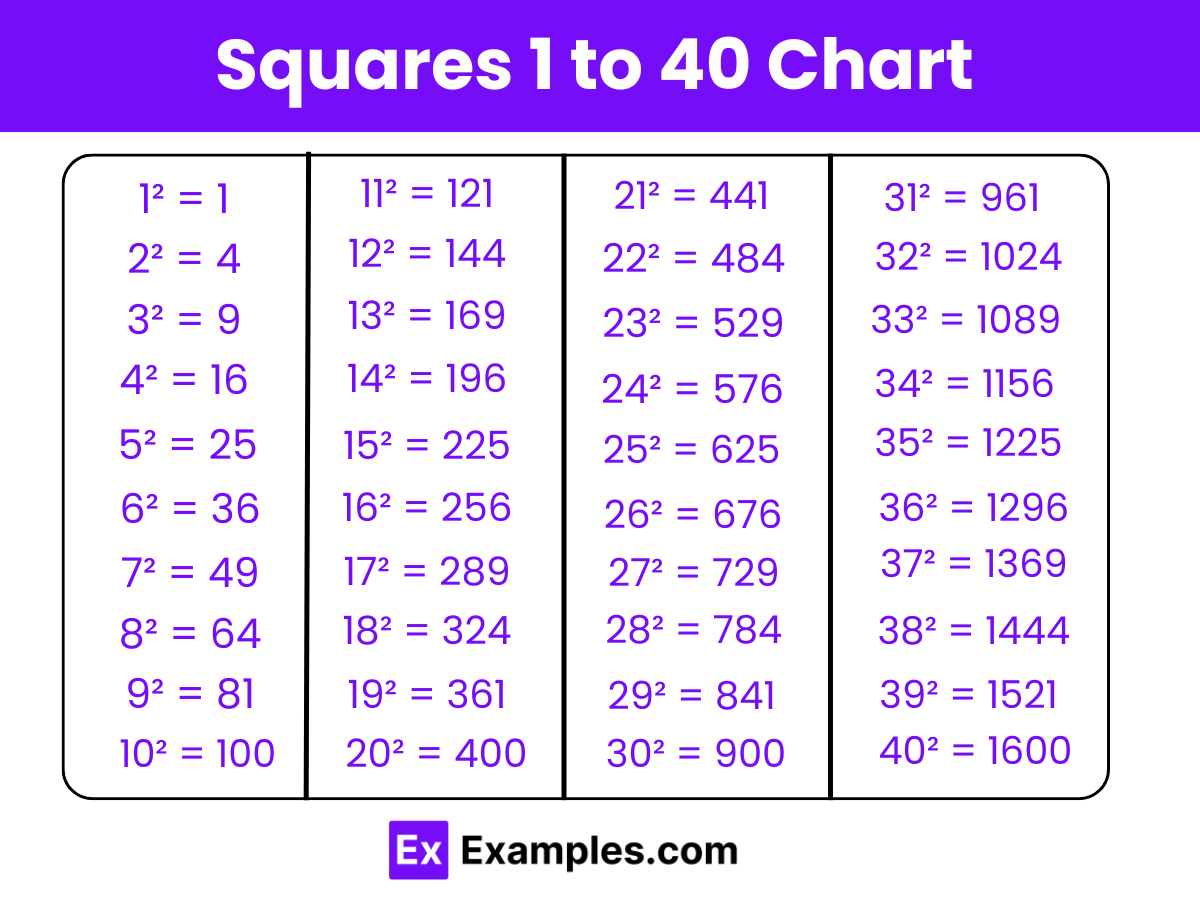What is the square of 5?
20
22
25
30


Exploring squares from 1 to 40 illuminates fundamental principles of mathematics, encompassing algebraic expressions, integer properties, and the concept of rational and irrational numbers. Understanding the relationship between perfect squares and their squares and square roots is crucial in algebra and number theory, laying the groundwork for advanced mathematical concepts. This sequence of squares serves as a cornerstone for analyzing quadratic equations and applying the least square method in statistics. The study of these squares enhances numerical literacy, fostering a deeper understanding of mathematical patterns and relationships.
Download Squares 1 to 40 in PDF
The squares from 1 to 40 represent the result of multiplying each integer in this range by itself, showcasing fundamental mathematical operations and providing insights into quadratic growth patterns. Understanding these squares is essential for various mathematical concepts, including algebra, number theory, and statistical analysis.
Highest Value: 40² = 1600
Lowest Value: 1² = 1

Download Squares 1 to 40 in PDF
| List of All Squares from 1 to 40 | |
|---|---|
| 1² = 1 | 21² = 441 |
| 2² = 4 | 22² = 484 |
| 3² = 9 | 23² = 529 |
| 4² = 16 | 24² = 576 |
| 5² = 25 | 25² = 625 |
| 6² = 36 | 26² = 676 |
| 7² = 49 | 27² = 729 |
| 8² = 64 | 28² = 784 |
| 9² = 81 | 29² = 841 |
| 10² = 100 | 30² = 900 |
| 11² = 121 | 31² = 961 |
| 12² = 144 | 32² = 1024 |
| 13² = 169 | 33² = 1089 |
| 14² = 196 | 34² = 1156 |
| 15² = 225 | 35² = 1225 |
| 16² = 256 | 36² = 1296 |
| 17² = 289 | 37² = 1369 |
| 18² = 324 | 38² = 1444 |
| 19² = 361 | 39² = 1521 |
| 20² = 400 | 40² = 1600 |
This content lists the squares of numbers from 1 to 20 and their values, showcasing the result of multiplying each integer by itself. It provides a clear demonstration of the quadratic growth pattern exhibited by perfect squares, essential in mathematics and various applications.
| 2² = 4 | 22² = 484 |
| 4² = 16 | 24² = 576 |
| 6² = 36 | 26² = 676 |
| 8² = 64 | 28² = 784 |
| 10² = 100 | 30² = 900 |
| 12² = 144 | 32² = 1024 |
| 14² = 196 | 34² = 1156 |
| 16² = 256 | 36² = 1296 |
| 18² = 324 | 38² = 1444 |
| 20² = 400 | 40² = 1600 |
This content displays the squares of even numbers from 1 to 40, highlighting the result of multiplying each even integer by itself and illustrating the quadratic growth pattern of perfect squares. It offers insight into the relationship between even numbers and their squares, fundamental in algebra and number theory.
| 1² = 1 | 21² = 441 |
| 3² = 9 | 23² = 529 |
| 5² = 25 | 25² = 625 |
| 7² = 49 | 27² = 729 |
| 9² = 81 | 29² = 841 |
| 11² = 121 | 31² = 961 |
| 13² = 169 | 33² = 1089 |
| 15² = 225 | 35² = 1225 |
| 17² = 289 | 37² = 1369 |
| 19² = 361 | 39² = 1521 |
This content showcases the squares of odd numbers from 1 to 40, demonstrating the result of multiplying each odd integer by itself and illustrating the quadratic growth pattern of perfect squares. It provides insight into the relationship between odd numbers and their squares, fundamental in algebra and number theory.
To calculate the squares of numbers from 1 to 40:
The squares of numbers from 1 to 40 range from 1 to 1600. They represent the result of multiplying each integer by itself, showcasing a quadratic growth pattern fundamental in mathematics.
o calculate the square of a number, you multiply the number by itself. For example, the square of 7 is 7 × 7 = 49.
You can use mnemonic devices, visualizations, and practice techniques to memorize the squares efficiently. Breaking the numbers into smaller groups and identifying patterns can also aid in memorization.
Understanding squares is essential in various fields such as engineering, physics, and computer science. It is used in calculations involving areas, volumes, distances, and more.
Numbers that are the squares of integers are called perfect squares because they represent the area of a square with integer side lengths.
Text prompt
Add Tone
10 Examples of Public speaking
20 Examples of Gas lighting
What is the square of 5?
20
22
25
30
If the side length of a square is 6 units, what is the area of the square?
36 square units
32 square units
30 square units
38 square units
What is the next perfect square after 16?
18
20
24
25
Which of the following numbers is a perfect square?
27
28
30
36
What is the difference between the squares of 7 and 6?
11
12
13
14
Which of the following numbers is the square of an even number?
9
16
25
35
What number squared equals 36?
5
6
7
8
What is the sum of the squares of 4 and 2?
16
18
20
24
Which of the following numbers is not a perfect square?
16
20
25
36
What is the next perfect square after 9?
10
12
16
18
Before you leave, take our quick quiz to enhance your learning!

